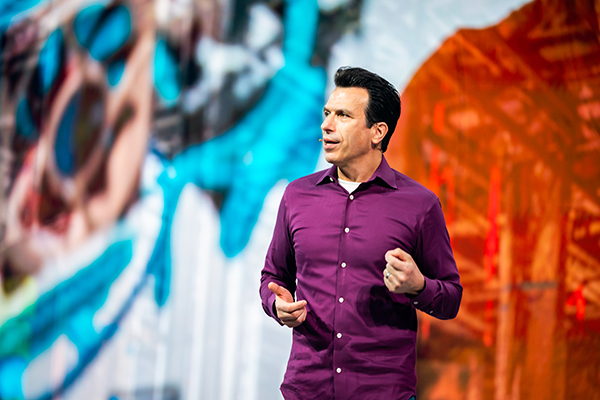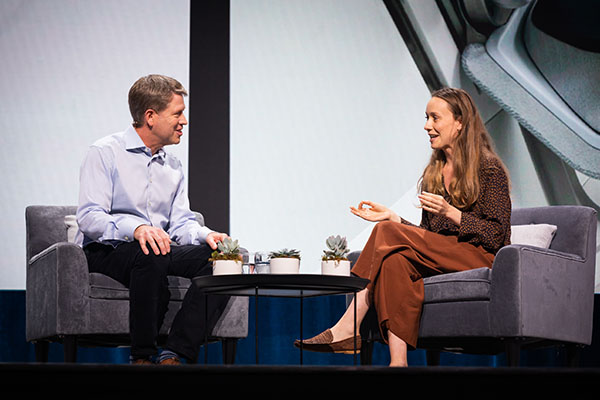
A marching band opens AU 2022 in New Orleans with “When the Saints Go Marching in.” Image courtesy of Autodesk.
Latest News
October 10, 2022
Autodesk CEO Andrew Anagnost had a tough act to follow. His keynote at the Autodesk University (AU) 2022 in New Orleans was preceded by a marching band with growling horns and brasses, playing “When the Saints Go Marching In.” So to top it, he appeared in a wizard's outfit (a variation of Gandalf's garb from Lord of the Rings). This was a nod to Day One's guest speaker Eric Iverson, head of product strategy, Amazon Studios, responsible for the new Rings of Power series now streaming on Amazon Prime.
“We have over 9,000 live attendees, but there are tens of thousands of people watching us online,” Anagnost said. Live attendance requires an admission fee, on top of the airfare and hotel costs. Before the pandemic, AU offered the AU Online option for a nominal fee. This year, the digital pass for AU is free. According to Autodesk PR, 28,000 registered for the remote option this year. (For more on how tradeshows fared in the pandemic, read “Between Zoomland and Las Vegas,” July 2021.)
The New Autodesk Cloud Trinity
During the pandemic shutdown, cloud-hosted design and collaboration platforms got a chance to shine. And it seems the afterglow is not fading away but here to stay. Autodesk is reorganizing its portfolios around three cloud platforms dedicated to the main segments it serves: Autodesk Forma for architecture, engineering, and construction (AEC); Autodesk Flow for media and entertainment (M&E); and Autodesk Fusion for product design and manufacturing.
“We're making great progress building our three industry clouds,” Anaghost said. “Each cloud will enable you to manage your assets and workflows more efficiently to connect the right people to the right data at the right time.” Furthermore, these clouds are not incremental improvements to the company's major software titles, but “they will help you drive an entirely new way of working,” he added.
Anagnost promised to make the shared services in the clouds “extensible, accessible, and open.” Some of these features and APIs are part of Autodesk Forge, but “moving forward, they will be known as Autodesk Platform Services,” Anagnost revealed.
With this paradigm, Autodesk is inviting third-party developers to create plug-ins and add-ons running on its platforms. The Fusion plug-in for real-time feedback of manufacturing cost and Revit plug-in for instant lifecycle assessments show what's possible.
Anagnost singled out Fusion as “the furthest along of all three clouds.” Later, in the Q&A session with the media, he clarified, “Files and file formats are dead things walking. Data stored in the cloud that can be instantly accessed, is the future. Fusion is significantly further along in being a file-free environment. The underlying product information model either constrains you or liberates you to move faster. Fusion is functionally more mature.”
Ancillary products like Autodesk Eagle (for PCB design) and Delcam (for CAD/CAM) used to be standalone titles, but are now part of Autodesk Fusion 360, Anagnost pointed out.

Partnerships Add PCB and Machining Features to Fusion 360
Autodesk's partnership with simulation software maker Ansys, first revealed at AU 2019, is getting stronger, according to Jeff Kinder, Executive VP of Product Development and Manufacturing Solutions, Autodesk.
“We’re announcing a new milestone in our ongoing strategic partnership with Ansys. Industry-leading Ansys simulation technology is being integrated into Fusion 360 to power a new extension that will quickly provide useful insights about printed circuit board (PCB) signal quality as a part of the board design process,” he revealed in his blog post.
The new Signal Integrity Extension driven by Ansys technology adds more PCB design functions to Autodesk Fusion 360.
Autodesk has also struck a partnership with ModuleWorks, which specializes in toolpath creation and simulation. “Earlier this year, we began combining advanced toolpath creation algorithms from ModuleWorks with enhanced 5-axis machining and other complex manufacturing workflows originally from Autodesk PowerMill into our Machining Extension. The result: new capabilities are coming to Fusion’s Machining Extension that generate higher-performance, collision-free toolpaths for efficient multi-axis milling,” wrote Kinder.
Integrating machining and tooling simulation is one way major 3D CAD vendors compete with one another. Recently, PTC announced the acquisition of CloudMilling, preparing to bolster its browser-based CAD program Onshape's machining functions.
Partnership with Epic Games
Autodesk also announced a partnership with Epic Games, one of the two major game engine providers. The announcement says the two are starting “a strategic collaboration to accelerate immersive real-time 3D experiences across industries, with an initial focus on architecture, engineering and construction (AEC).”
Epic Games's technology will be crucial to help bring 3D designs into AR-VR applications for digital twins-driven training and analysis. James Branagan, Reality Capture Solutions Consultant, IMAGINiT, noted, “We're seeing a lot more people embracing remote training, including VR. This is especially true for companies that conduct safety training. They let employees walk through the critical processes in the digital world before bringing them into the real environment.”
To lay the foundation for such workflows, Branagan pointed out, “reality capture software and hardware are the first step. You need to scan the factory floor to bring it into the VR environment. Once you got that data, then you can do safety training with it, or analyze different layouts. It's easier to bring this data into a game engine, then view it in VR.”
IMAGINiT, an Autodesk Platinum Partner, offers Autodesk software-based training and professional services.
Reversing the Disposable Culture
On Day Two, guest speaker Caroline Jacob, Lead Strategist for Seymourpowell, joined Kinder. She champions social and sustainable design projects, as exemplified in the company's project with Fairphone to develop not a disposable phone but an upgradable, repairable one.
“The longer the phone lasts, the lower its environmental footprint,” Jacobs said. “It was with Autodesk Fusion 360 that our team was able to work efficiently across multiple departments. What I love about the project was, for the first time, it gave the consumer the choice to go against the trend of replacing a phone every 18 months.”
Recently, DE contributor Randall Newton reported on the Right to Repair movement. Zoé Bezpalko, Autodesk's Sustainability Strategy Manager, pointed out, “We see design for repair as a sustainability integrated topic.”

More Autodesk Coverage
Subscribe to our FREE magazine, FREE email newsletters or both!
Latest News
About the Author
Kenneth Wong is Digital Engineering’s resident blogger and senior editor. Email him at [email protected] or share your thoughts on this article at digitaleng.news/facebook.
Follow DE






